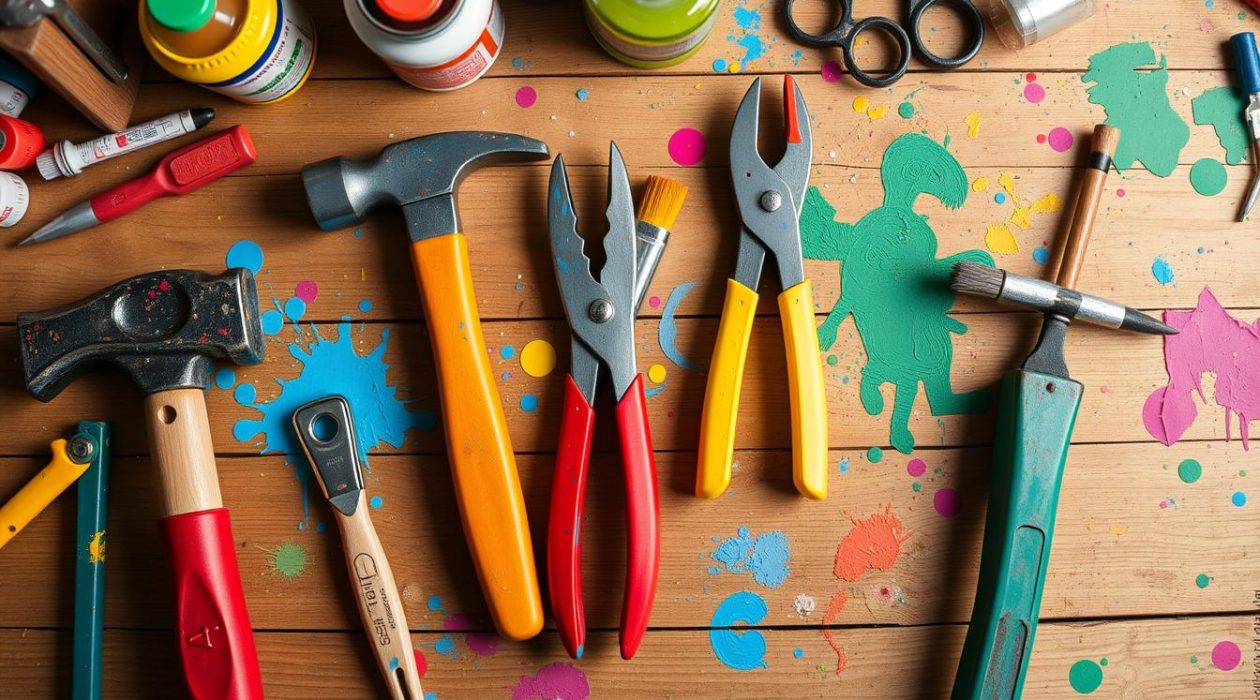Explore the realm of tool hacks, where creative hand tool uses and tricks elevate DIY projects. With dedication and patience, you can become proficient in tool hacks, transforming into a DIY master.
Tool hacks involve innovative thinking, finding novel uses for common tools. This approach saves time, money, and effort in DIY endeavors. It’s beneficial for both seasoned DIY enthusiasts and novices, leading to superior results.
Embracing tool hacks and hand tool tricks opens up a universe of creative potential. It propels your DIY abilities to unprecedented levels. So, why not experiment and witness the impact of creativity and clever tool hacks?
Key Takeaways
- Tool hacks can help you save time and money on DIY projects
- Creative hand tool uses can take your DIY skills to the next level
- Hand tool tricks can help you achieve professional-grade results
- Tool hacks are all about thinking outside the box and finding new ways to use everyday tools
- With practice and patience, anyone can master the art of tool hacks
- Tool hacks can help you unlock a world of creative possibilities
Understanding the Art of Tool Hacks
In DIY projects, the right tools are crucial. Yet, the most effective tools are often those you create through DIY hacks. These hacks save time, money, and effort. They also encourage innovative solutions to common problems.
A creative and practical tool hack solves specific problems or simplifies tasks. For instance, using a drill as a mixer or a saw as a scraper. These hacks are versatile, applicable in woodworking and metalworking. They make you more self-sufficient and resourceful.
What Makes a Good Tool Hack
A good tool hack is safe, effective, and easy to use. It must withstand repeated use and be durable. Key considerations include materials, design, and potential risks.
Safety Considerations When Repurposing Tools
Repurposing tools requires careful safety consideration. Ensure the tool is used safely and controlled. Wear protective gear and use tools in well-ventilated areas.
Basic Principles of Tool Adaptation
Understanding tool properties and capabilities is key to adaptation. Consider materials, design, and applications. This knowledge helps you create DIY hacks, enhancing your DIY skills.
- Using a drill as a mixer
- Using a saw as a scraper
- Creating a custom tool holder
- Modifying a tool to fit a specific task
By applying these DIY tool hacks, you elevate your DIY projects. You become more efficient and effective in your work.
Essential Hand Tools for Creative DIY Applications
For those diving into creative DIY projects, the right hand tools are crucial. A variety of hand tool tricks and creative hand tool uses empower DIY enthusiasts to take on diverse projects confidently. Essential tools include hammers, screwdrivers, pliers, and wrenches, setting the stage for success.
A comprehensive toolbox is vital for any DIY endeavor. Among the most versatile tools are:
- Hammers for driving nails and fitting parts together
- Screwdrivers for driving screws and other fasteners
- Pliers for gripping and bending objects
- Wrenches for tightening and loosening bolts and nuts
By honing hand tool tricks and creative hand tool uses, you unlock a realm of DIY possibilities. Whether you’re an experienced DIYer or a novice, the right tools can elevate your projects to professional standards.
Armed with the correct tools and creativity, even the most intricate DIY tasks become manageable. So, why not begin today and explore the limits of your hand tool tricks and creative hand tool uses?
Unexpected Uses for Common Hammers
Many overlook the humble hammer in DIY tool hacks. Yet, this versatile tool has a multitude of uses. It’s perfect for tapping into tight spaces or breaking apart objects. A hammer is a must-have in any toolkit.
Using a hammer as a makeshift tapping tool is quite creative. Wrap the head in cloth or rubber to avoid damage. This method is ideal for working with fragile materials like glass or ceramic.
Beyond Nailing: Creative Hammer Applications
A hammer’s uses extend beyond nailing. It can serve as a pry bar, chisel, or even a sculpting tool. With creativity, the DIY tool hacks are limitless. For instance, you can shape metal or break apart rocks or concrete with a hammer.
Hammer Modifications for Specific Projects
Modifying your hammer can enhance its functionality for specific projects. Adding a rubber grip to the handle improves traction. You can also attach a magnetic strip to the head for picking up small metal objects. These simple tweaks can transform your hammer into a specialized tool.
| Hammer Type | Modification | Use |
|---|---|---|
| Claw Hammer | Rubber Grip | Improved Traction |
| Ball Peen Hammer | Magnetic Strip | Picking up Small Metal Objects |
Revolutionary Screwdriver Techniques
Screwdrivers are often seen as simple tools, but they hold a wealth of potential. With the right approach, they can become crucial for any DIY endeavor. Techniques like adjustable torque and precision driving make them indispensable. Mastering these methods can streamline your work and enhance your results.
Effective uses of screwdrivers include prying, chiseling, and even marking surfaces. Adjustable torque screwdrivers excel in delicate tasks, offering precise control. For tight spaces and detailed work, precision driving screwdrivers are the go-to choice.
Here are some hand tool tricks to maximize your screwdriver’s potential:
- Use a screwdriver with a magnetic tip to pick up small screws and metal parts
- Apply a small amount of lubricant to the screwdriver tip for smoother operation
- Use a screwdriver with an adjustable handle for increased comfort and control
By embracing these techniques, you can elevate your DIY projects. Whether you’re a novice or a seasoned pro, mastering screwdriver techniques can significantly improve your work. It’s a game-changer for any DIY enthusiast.
Pliers: The Most Versatile Tool in Your Arsenal
Pliers are a must-have for DIY enthusiasts and professionals alike. They offer a multitude of uses and applications. By learning DIY tool hacks and exploring unique tool applications, you can maximize your pliers’ potential.
Pliers excel at providing a firm grip on various objects. Techniques like adding rubber grips or using plier accessories can enhance their performance. Specialized pliers, such as needle-nose or locking pliers, make specific tasks easier.
Grip Enhancement Techniques
- Adding rubber grips to improve traction
- Using plier accessories, such as grip extenders
- Applying lubricants to reduce friction
Specialized Plier Applications
Specialized pliers, like needle-nose or locking pliers, offer unique benefits. Needle-nose pliers are perfect for small spaces and tiny objects. Locking pliers provide a secure grip, making manipulation easier.
Combining Pliers with Other Tools
Using pliers with other tools can enhance your toolkit’s versatility. By combining pliers with wrenches or screwdrivers, you can tackle complex tasks. With practice, you can develop unique tool applications tailored to your needs.
| Tool Combination | Application |
|---|---|
| Pliers and Wrench | Tightening and loosening bolts and nuts |
| Pliers and Screwdriver | Driving screws and other fasteners |
Advanced Tool Hacks for Professional-Grade Results
For those aiming at professional-grade DIY results, hand tool tricks are crucial. Mastering creative hand tool uses can elevate your projects, making them comparable to those of seasoned professionals. This is about achieving high-quality outcomes.
Exploring advanced tool hacks is key. This includes modifying and customizing tools for better performance. For instance, using hand tool tricks can enhance grip, precision, and control. Here are a few examples:
- Using a hammer with a customized handle for better grip and leverage
- Modifying a screwdriver to fit into tight spaces
- Creating a hybrid tool by combining different tools for unique applications
By employing these creative hand tool uses, you can unlock new possibilities in your DIY endeavors. This leads to professional-grade results with ease and efficiency. Plus,
With the right hand tool tricks and creative hand tool uses, anyone can become a DIY expert. They can produce high-quality results that are both functional and visually appealing.
| Tool | Modification | Result |
|---|---|---|
| Hammer | Customized handle | Improved grip and leverage |
| Screwdriver | Modified tip | Increased precision and control |
Transforming Basic Tools into Specialized Equipment
Basic tools can be transformed into specialized equipment with a bit of creativity. DIY enthusiasts can tackle complex projects with ease by applying DIY tool hacks. This approach allows for unique tool applications that simplify tasks and enhance results.
Custom Tool Modifications
Custom tool modifications involve altering existing tools to meet specific needs. This can be done through various methods, such as adding attachments or modifying the tool’s design. For instance, a drill press can be converted into a mortise machine by adding a specialized attachment.
Creating Hybrid Tools
Creating hybrid tools involves combining different tools to create a new, versatile tool. This can be achieved by attaching a rotary tool to a drill or combining a saw with a sanding machine. Hybrid tools save space, reduce costs, and increase efficiency.
Tool Adaptation for Unique Materials
Tool adaptation for unique materials involves modifying tools to work with specialized materials, such as glass, metal, or wood. This can be achieved by using different blades, bits, or attachments. For example, a glass cutter can be adapted to cut metal by using a diamond-coated blade.
By applying these techniques, DIY enthusiasts can create unique tool applications that simplify tasks and improve results. With creativity and experimentation, basic tools can be transformed into specialized equipment. This allows individuals to tackle complex projects with ease and confidence.
| Tool | Modification | Result |
|---|---|---|
| Drill Press | Mortise Attachment | Mortise Machine |
| Rotary Tool | Drill Attachment | Hybrid Drill |
| Glass Cutter | Diamond-Coated Blade | Metal Cutter |
Money-Saving Tool Hacks for Budget Projects
Working on a budget project requires finding ways to cut costs without sacrificing quality. Utilizing hand tool tricks and creative hand tool uses is a key strategy. By exploring alternative uses for common tools, you can save money and still achieve professional results.
Practical tips for saving on tools include repurposing old tools, optimizing tool usage, and investing in versatile tools. For example, a hammer is not just for driving nails but also for tapping, shaping, and breaking objects. Pliers can grip, bend, and twist various materials.
Here are some money-saving tool hacks to consider:
- Use a wire cutter as a makeshift bolt cutter for smaller projects
- Repurpose an old screwdriver as a chisel or scraper
- Utilize a drill press as a mortise or tenon machine
By embracing hand tool tricks and creative hand tool uses, you can significantly reduce tool expenses. This allows you to allocate more resources to other project aspects. Always prioritize safety and quality when experimenting with new tool uses. Online resources and tutorials can provide inspiration and guidance.
With creativity and resourcefulness, you can turn a budget project into a successful and cost-effective endeavor. Start exploring hand tool tricks and creative hand tool uses today. Discover the countless possibilities that await you.
| Tool | Alternative Use |
|---|---|
| Hammer | Tapping, shaping, breaking apart objects |
| Pliers | Gripping, bending, twisting materials |
| Wire Cutter | Bolt cutter for smaller projects |
Innovative Measuring and Marking Tool Tricks
Measuring and marking are crucial in DIY projects, and the right tools are key. With clever DIY tool hacks, you can achieve precise results. A combination square is a standout hack for ensuring accurate measurements and markings.
Stud finders can also mark studs behind walls, aiding in hanging pictures or shelves. Laser levels are another gem, creating straight lines and ensuring measurements are spot on.
- Using a pencil with a built-in eraser to make quick and easy markings
- Creating a makeshift straightedge using a piece of wood or a ruler
- Using a level app on your smartphone to ensure that your measurements are accurate
Precision Marking Techniques
Precision marking is vital for accurate DIY results. Fine-tip markers are great for precise markings. Marking gauges help create consistent, accurate marks.
Alternative Measuring Methods
When traditional tools are scarce, alternative methods shine. String or flexible measuring tapes are perfect for curved shapes. Digital calipers excel in small, precise measurements.
| Tool | Description |
|---|---|
| Combination Square | A multi-purpose tool used for measuring and marking |
| Stud Finder | A tool used to locate studs behind walls |
| Laser Level | A tool used to create straight lines and ensure accurate measurements |
Combining Multiple Tools for Complex Projects
For large-scale projects, the right tools are essential. It’s not just about one tool, but combining several for the best outcome. Hand tool tricks enable creative problem-solving, making complex tasks manageable.
Using multiple tools boosts efficiency and productivity. For instance, a hammer and screwdriver together make screw driving easier. Pliers and a wrench offer more grip and leverage. These creative hand tool uses significantly enhance project results.
Some effective tool combinations include:
- Hammer and tape measure for accurate measurements
- Screwdriver and level for precise screw driving
- Pliers and wire cutters for cutting and gripping wires
To maximize tool effectiveness, experiment with different combinations. This practice helps you find the best approach for each project. With time and effort, you’ll master combining tools, elevating your DIY projects.
By embracing hand tool tricks and creative hand tool uses, you unlock new possibilities. Don’t hesitate to explore various tool combinations. You might discover innovative solutions.
| Tool Combination | Project Application |
|---|---|
| Hammer and screwdriver | Furniture assembly |
| Pliers and wrench | Pipe fitting |
| Tape measure and level | Construction |
Environmental Benefits of Tool Hacking
Embracing DIY tool hacks can greatly reduce our environmental impact. One key advantage is the decrease in waste. Repurposing or modifying tools extends their life, cutting down on the need for new ones and the waste they generate.
Some unique tool applications also help lower energy use. For instance, opting for hand tools over power tools can save energy and cut down on carbon emissions. Tool hacking also fosters sustainability by encouraging the use of recycled or reclaimed materials.
Here are some ways DIY tool hacks can benefit the environment:
- Reduce waste by extending the lifespan of tools
- Save energy by using hand tools or low-power alternatives
- Promote sustainability by using recycled or reclaimed materials
By adopting unique tool applications and DIY tool hacks, individuals can positively impact the environment. As global awareness of sustainability grows, tool hacking becomes crucial in reducing waste and promoting eco-friendly practices.
| Tool Hacking Benefits | Environmental Impact |
|---|---|
| Reduced waste | Conserves natural resources |
| Energy savings | Reduces carbon emissions |
| Promotes sustainability | Encourages use of recycled materials |
Mastering the Art of Creative Tool Usage
As we wrap up our exploration of hand tool hacks, it’s evident that creativity and innovation have no bounds. Embracing tool hacking opens up a world of possibilities for DIY enthusiasts and craftspeople. It allows them to transform simple tools into specialized equipment, meeting their unique needs.
We’ve seen how common tools can be used in unexpected ways. Techniques like revolutionary screwdriver methods have been showcased. These hand tool tricks, creative uses, and DIY hacks can take any project to the next level. By mastering these unique applications, you can achieve professional-grade results without breaking the bank.
The path to unlocking your full potential starts with a willingness to experiment and think outside the box. By continuously pushing the limits of traditional tool usage, you can turn your DIY dreams into reality. This approach also contributes to a more sustainable future, thanks to the environmental benefits of tool hacking.
So, start your own journey of tool mastery and let your imagination run wild. The possibilities are endless, and the rewards are immeasurable. Happy hacking!


